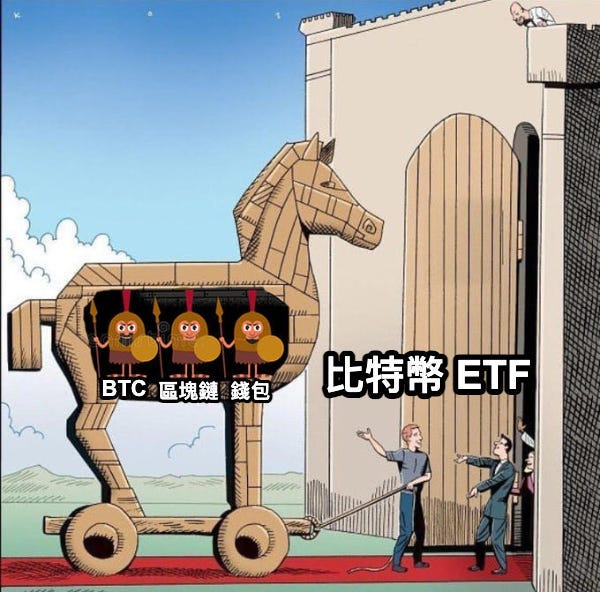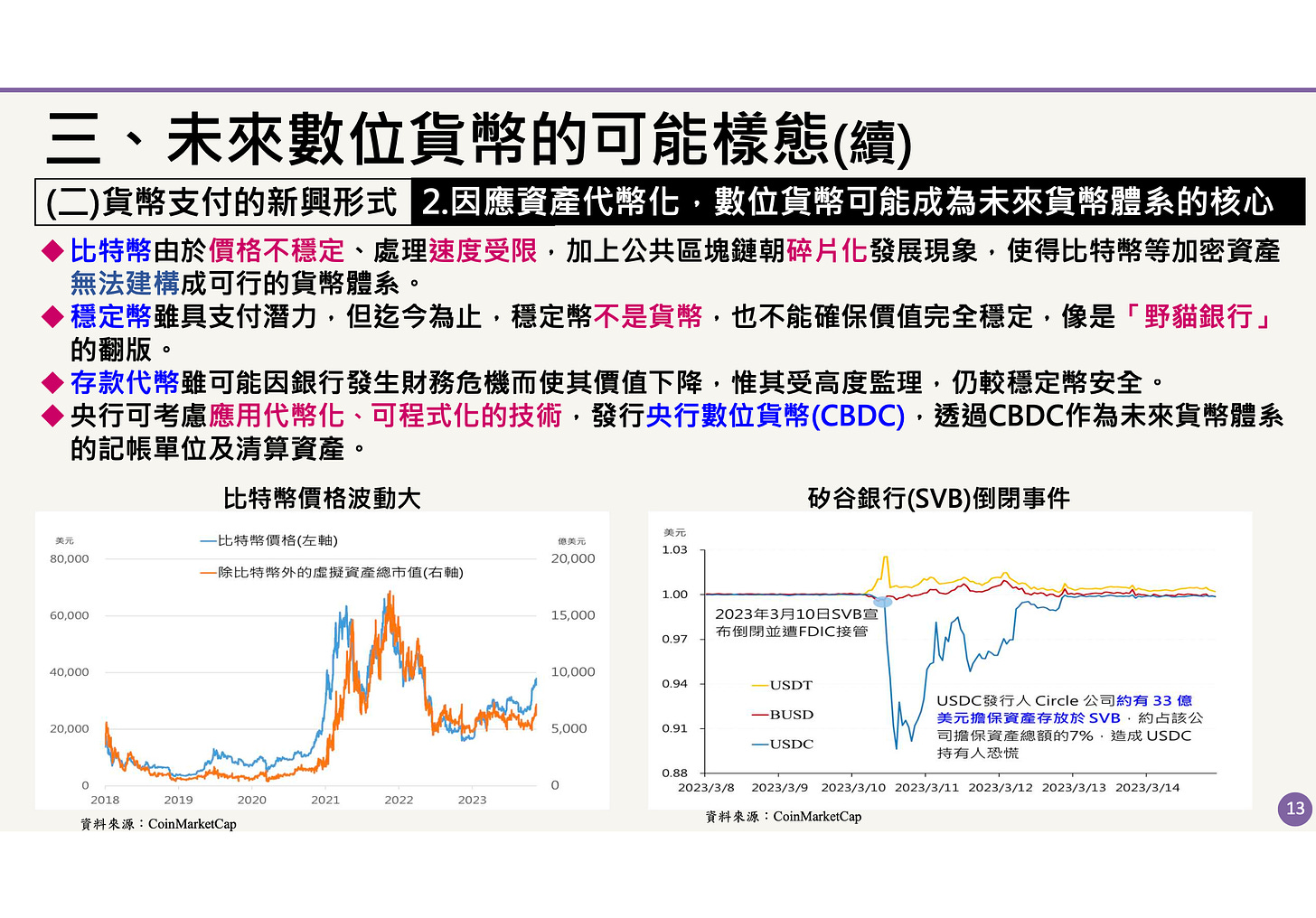GM,
Recently, the market's attention has been largely focused on the question of when the Bitcoin spot ETF will be approved. A Bitcoin ETF can contribute to the rise in coin prices, and I am optimistic about its prospects. However, in terms of financial innovation, a Bitcoin ETF is essentially a "backsliding" product—it repackages digital assets that can be traded peer-to-peer without admission requirements into stocks that can only be bought and sold on a stock exchange—investors indirectly hold Bitcoin through stocks.
Nevertheless, I am still optimistic about the advent of a Bitcoin ETF because it serves as the funnel's top. Some people's interest in Bitcoin only extends to its price, and they don't delve deeper after buying the ETF. However, I believe that after some people come into contact with ETFs, they will also become interested in the underlying Bitcoin. Ultimately, not only will the coin price rise, but there will also be an increase in people investing in Web3 development. This is where the value of a Bitcoin ETF lies.

At the end of 2023, Vitalik Buterin wrote a highly inspiring article titled "Make Ethereum Cypherpunk Again," outlining the long-term vision of Web3, its current development status, and the challenges encountered in the process. He mentioned that we are not just here to develop tools or games that are incompatible with reality but to create a more free and open society and economy.
This article is very suitable for reading at the moment, and even technology trends expert Kevin Kelly shared it, calling it a complete summary of the current development of Web3. However, it may not be an easy read for everyone. Some, like me, might already struggle with the title. What does "cypherpunk" mean?
Cypherpunk
Cypherpunk originally referred to individuals or groups using cryptographic techniques to achieve specific social goals, now typically indicating a social movement initiated by these people. The cypherpunk motto is "Privacy for the weak, transparency for the powerful," which is the opposite of the current digital world.
In the digital world of 2024, the least private individuals are personal users like you and me. Simply opening a browser, there are dozens of trackers monitoring our every move. Unfortunately, users have limited knowledge about internet giants like Google and Facebook, and even major events like the suspension of personal accounts may not receive a reasonable explanation.

The Cypherpunk movement originated in the 1990s. At that time, while most people had not yet started using the internet, a group of individuals foresaw the possibility of the internet developing in the wrong direction. In 1993, they published the "Cypherpunk Manifesto," advocating for individuals to fight for their privacy and autonomy using cryptography as a tool.
However, looking back now, the manifesto seems like "bay at the moon." The privacy of the weak has diminished, and the transparency of the powerful has decreased. In 2012, Julian Assange, the founder of WikiLeaks, wrote "Cypherpunks: Freedom and the Future of the Internet," showcasing how governments and corporations collaborated to dominate the digital world. It also confirmed that the concerns raised in the manifesto were not groundless.
Although the Cypherpunk movement went unnoticed by many, it continues to persist. Unlike 30 years ago, when people might have agreed with the Cypherpunk ideology but didn't know how to put it into practice, nowadays, merely using cryptocurrency is considered active participation in the Cypherpunk movement.
Put Into Practices
Cryptocurrency is one practical implementation of the Cypherpunk movement. It is cryptography-based and helps individuals reclaim control over their assets. However, Vitalik Buterin believes that the ultimate goal of cryptocurrency is not just creating a new asset class or becoming a more efficient transfer tool within the financial system but using it as a foundation to build a more free and open digital world.
Unfortunately, many governments and corporations find it challenging to understand or deliberately choose to ignore such a vision.
Last month, the Deputy Governor of the Central Bank of Taiwan, Shih Mei Lee, mentioned the tokenization of Real World Assets (RWA) in a keynote speech. She discussed the possibility that the foundation of the future monetary system could be composed of tokenized assets and Central Bank Digital Currencies (CBDC). At first glance, it seemed like progress in the central bank's perspective. Unfortunately, her next slide argued that Bitcoin could not construct a viable monetary system, and stablecoins were akin to "wildcat banking."

In other words, for central banks, blockchain and cryptocurrencies are currently excellent tools for efficiency improvement. However, whether it's BTC or stablecoins, they are all considered as "shitcoins" according to the central bank's perspective. As for the increasing market value of these "shitcoins" over time, it seems to be attributed to the growing number of blindly following masses, according to the logic of the central bank. The debate on whether Bitcoin has value was already settled on Bitcoin Pizza Day in 20101, but the central bank chooses to turn a blind eye.
Returning to Vitalik's article, despite his repeated emphasis that cryptocurrencies are not just tools but have a deeper purpose—building a more open digital world (or Web3)—most people likely find it challenging to understand the connection between cryptocurrencies and an open society.
Blocktrend previously exemplified, in the 2020 article "From Paper Money, Electronic Payments to a Monitored Society," the Chinese social credit system. When people anticipate that every action will be monitored by the government, self-censorship begins, ultimately leading to a more closed society. Ensuring individual privacy is crucial to constructing a more open and free society.
Besides privacy, another layer of freedom is autonomy. Vitalik used the early open-source software movement as an example:
Back then, software was simple, with all operations and data processing done on one's personal computer. However, most significant work nowadays requires collaboration, sometimes on a large scale. Even if the underlying code of an application is publicly available and freely accessible on the internet, your data might still be stored on centralized servers, allowing them to change rules or deny you access at any time. If we want to expand the spirit of open source to the present, we need decentralized storage to store everyone's belongings.
In the article, Vitalik included an early concept image of Ethereum. The author of this image is Gavin Wood, another co-founder of Ethereum and an early advocate of the "Web3" concept globally.
Vitalik mentioned that when they were discussing what Ethereum was back then, he thought of it as "Bitcoin plus smart contracts," but Gavin, from a broader perspective, believed that Ethereum should be seen as one of the three elements constructing Web3. In addition to the smart contract platform, Web3 should also include Swarm for decentralized storage and Whisper for decentralized communication to be considered complete.

In essence, decentralization allows users to become service providers themselves. When everyone can be a part of the internet, infrastructure won't be monopolized by a few, creating a more open internet. This could be considered the most fitting moment for Ethereum and the Cypherpunk movement's ideals. However, since 2017, Ethereum's development has taken a divergent path.
Deviation and Return
While everyone is familiar with Ethereum, few have heard of Swarm and Whisper. When people think of Web3, they likely associate it mainly with cryptocurrencies, but Vitalik believes Ethereum deviated from its original vision. The high on-chain transaction fees have made it difficult for non-financial application developers to afford the cost of on-chain operations. As a result, Ethereum has gradually been "occupied" by financial applications, and Web3 has become synonymous with cryptocurrencies.
Unfortunately, since 2017, these visions have been gradually forgotten. The only remaining on-chain non-financial application is ENS (Ethereum Name Service). If the cost of on-chain transactions were $0.001, people would create various on-chain applications. However, when on-chain transaction fees exceed $100, only DeFi enthusiasts (DeGen) would spend money to participate. Moderate DeGen may not be an issue. Many people initially entered the crypto space for financial reasons but stayed for ideals. However, when DeGen becomes the main group, it affects public perception and internal culture, resulting in negative consequences.
Reducing the operational costs of blockchain will enable more non-financial application developers to see the potential of on-chain activities. As more applications start going on-chain, it can attract participants from diverse backgrounds into Web3, beyond just the pursuit of financial gains.
In the past year of 2023, Ethereum's second-layer networks flourished, and on-chain transaction fees decreased rapidly. If the Cancun upgrade is completed as scheduled in 20242, reducing on-chain transaction fees to the current 1%, not only can non-financial applications survive, but it may also bring new business models. For instance, companies might be willing to subsidize user transaction fees to facilitate more seamless participation. This is why Vitalik wrote "Make Ethereum Cypherpunk Again" at the end of 2023—the timing is right.
However, transaction fees are just the most palpable issue for people right now, not the only problem. For example, if investors still entrust their assets to centralized exchanges instead of personal wallets, true autonomy has not been regained. Or, when participating in staking on the Cosmos network, people prefer staking tokens with large nodes like Coinbase Cloud that rarely engage in governance, rather than staking with smaller nodes like DHK DAO that actively participate in voting. This diminishes the system's overall resilience.
After reading Vitalik's article, one might experience a mind-blowing sensation. Almost every example challenges existing perceptions. For instance, he mentions the widespread adoption of zero-knowledge proof technology3, allowing us to move beyond the erroneous binary relationship of "anonymous but risky" versus "real-name, therefore secure." He advocates the coexistence of privacy and security, emphasizing that even with complete transparency, there are still risks. This cognitive impact, challenging fundamental knowledge, might make one wonder if he is speaking nonsense.
However, this is precisely why I recommend this article to everyone. Vitalik, through Ethereum, encourages us to reconsider alternative possibilities for constructing a digital world.
Blocktrend is an independent media sustained by reader subscriptions. If you find Blocktrend articles valuable, feel free to share this piece. You can also join discussions on the member-established Discord or save this Writing NFTto add this article to your Web3 records.
Furthermore, please recommend Blocktrend to your friends and family. If you successfully refer a friend who subscribes, you'll receive a one-month membership extension for free. You can check the article list for past publications. In response to frequent inquiries about referral codes, I have compiled them on one page. Feel free to use them.